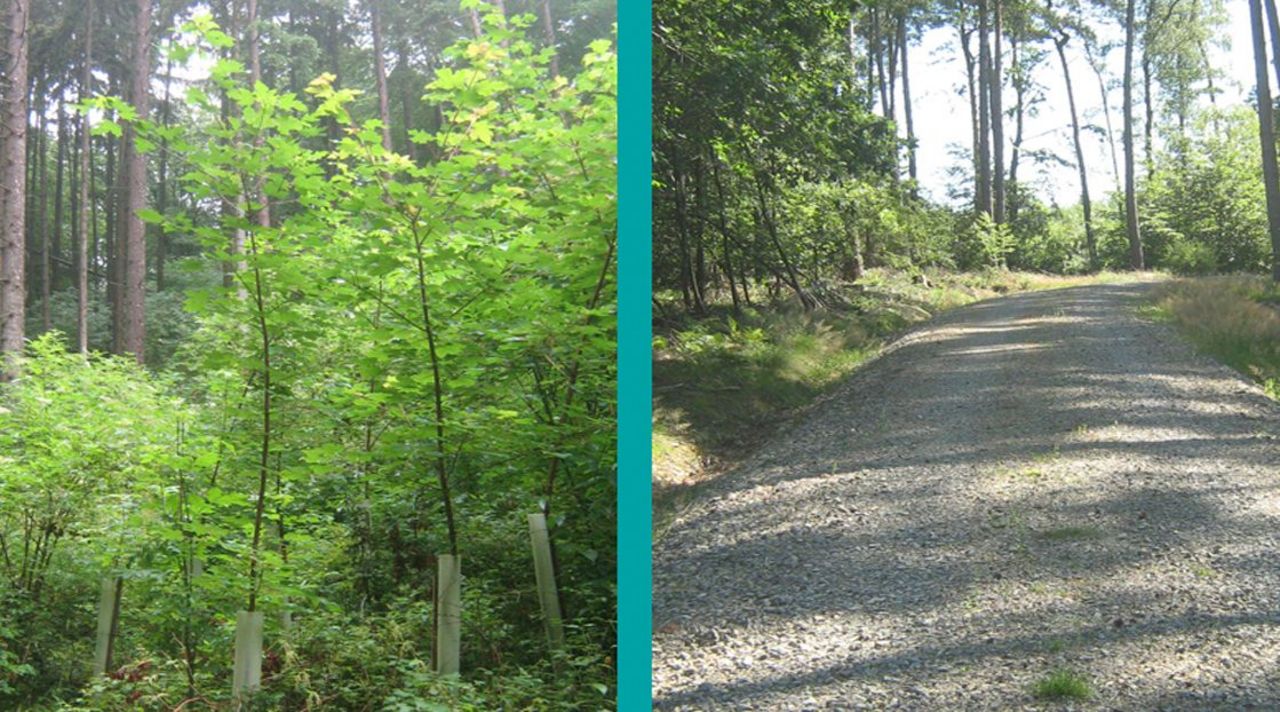Project
5-State-Evaluation: Forestry related measures

Monitoring and evaluation of Rural Development Programmes according to VO (EG) 1305/2013 for the states Hesse, Lower Saxony/Bremen, North Rhine-Westphalia and Schleswig-Holstein - Evaluation of forest financing
The evaluation at the Institute of Forestry covers the forest related measures of three rural development programs. We examine the measure effects on biodiversity, water, soil and climate protection and on competitiveness of forest enterprises. Furthermore we analyze the implementation procedures to recognize if there are implementation obstacles.
Background and Objective
Forest related measures within the rural development programs have the target to support forest owners in the sustainable and natural management of their forests. The most important measures to achieve this target are forest conversion, soil liming and forest road construction. In addition, different nature protection measures and wood processing are eligible, inter alia. Within evaluation we check if the measures are appropriate to solve the detected problems (relevance), if the chosen aims are achieved (target achievement) and if the measures are designed in a way that the intended impacts could occur (impact and causality).
Evaluation of the forest related measures takes place within evaluation of the whole Rural Development Programmes.
Target Group
Main target groups are the EU, the federal and regional level which are financing rural development programmes. Furthermore, evaluation results are aimed to the professional public and scientific community.
Approach
The first step is the measure check: What are the specific objectives? Is the design of the measure appropriate /coherent with their objectives? Who are the intended beneficiaries? The next step is the analysis of the delivery: How many projects have been funded? How much public money was spent? Are there obstacles in the design of measures which prevent potential beneficiaries from applying for funding? Are the administrative procedures clear and easy to handle? Later on, impact analyses of the measures have a higher priority.
Data and Methods
We use data from the funding-departments in the ministries and their administration and from general environmental monitoring of forest ecosystems, like National Forest Inventory. Furthermore we analyze secondary data sources and conduct own surveys and case studies.
Our Research Questions
Specifically, as part of the evaluation, we ask: What is the impact of forestry support on the associated objectives; what is the impact of the supported measures on biodiversity as well as water, soil and climate protection and the competitiveness of forest enterprises?
Links and Downloads
Thünen-Contact

Involved Thünen-Partners
Involved external Thünen-Partners
- entera
(Hannover, Deutschland)
Former project member at the Thünen Institute
Duration
5.2015 - 12.2024
More Information
Project status:
ongoing
Publikations
- 0
Rorig F (2023) Beitrag der forstlichen Förderung für die Wasserqualität und -quantität : NRW-Programm Ländlicher Raum 2014 bis 2020 [online]. Hamburg: Thünen-Institut für Waldwirtschaft, 27 p, 5 Länder Eval 2023/01, zu finden in <https://www.eler-evaluierung.de/fileadmin/eler2/Publikationen/Projektberichte/5-Laender-Bewertung/2023/1-2023_Eval-Bericht_Wald_Wasser_NRW.pdf> [zitiert am 17.01.2023], DOI:10.3220/5LE1673967472000
- 1
Rorig F (2022) Effekte der forstlichen Fördermaßnahmen des Landesprogramms Ländlicher Raum (LPLR) des Landes Schleswig-Holstein auf die Wasserqualität und -quantität [online]. Hamburg: Thünen-Institut für Waldwirtschaft, 21 p, 5 Länder Eval 2022/09, zu finden in <https://www.eler-evaluierung.de/fileadmin/eler2/Publikationen/Projektberichte/5-Laender-Bewertung/2022/9_2022-SH_WaldWasserBericht.pdf> [zitiert am 15.11.2022], DOI:10.3220/5LE1668000644000
- 2
Franz K (2021) How can forest funding instruments be designed so that they are accepted by forest owners? Allg Forst Jagdzeitg 191(7/8):129-142, DOI:10.23765/afjz0002064
- 3
Sander A, Franz K (2019) Entwicklungsplan für den ländlichen Raum (EPLR) des Landes Hessen 2014 bis 2020 : Beiträge zur Evaluation des Schwerpunktbereichs 4A Biologische Vielfalt [online]. Hannover ; Hamburg: entera Umweltplanung ; Thünen-Institut für Internationale Waldwirtschaft und Forstökonomie, 91 p, 5 Länder Eval 2019/9, zu finden in <https://www.eler-evaluierung.de/fileadmin/eler2/Publikationen/Projektberichte/5-Laender-Bewertung/2019/9_19_HE-Berichte_aus_der_Evaluation-SPB4a.pdf> [zitiert am 04.06.2019], DOI:10.3220/5LE1559650318000
- 4
Franz K (2019) Entwicklungsplan für den ländlichen Raum des Landes Hessen 2014 bis 2020 : Evaluation der forstlichen Förderung. Hamburg: Thünen-Institut für Internationale Waldwirtschaft und Forstökonomie, 35 p, 5 Länder Eval 2019/6, DOI:10.3220/5LE1553674335000
- 5
Raue P, Bathke M, Eberhardt W, Ebers H, Fengler B, Forstner B, Franz K, Grajewski R, Pollermann K, Pufahl A, Reiter K, Sander A, Roggendorf W (2019) Ergebnisse der laufenden Bewertung des Landesprogramms Ländlicher Raum (LPLR) des Landes Schleswig-Holstein 2014 bis 2020 : Beitrag zu Kapitel 7 des erweiterten Durchführungsberichts 2018. Braunschweig: Thünen-Institut für Ländliche Räume, 199 p, 5 Länder Eval 2019/14, DOI:10.3220/5LE1567595848000
- 6
Franz K (2019) Landesprogramm Ländlicher Raum (LPLR) des Landes Schleswig-Holstein 2014 bis 2020 : Forstliche Förderung. Hamburg: Thünen-Institut für Internationale Waldwirtschaft und Forstökonomie, 30 p, 5 Länder Eval 2019/3, DOI:10.3220/5LE1551085524000
- 7
Sarvasova I, Ali T, Dordevic I, Lukmine D, Quiroga S, Suárez C, Hrib M, Rondeux J, Mantzanas KT, Franz K (2019) Natura 2000 payments for private forest owners in Rural Development Programmes 2007–2013 - a comparative view. Forest Pol Econ 99:123-135, DOI:10.1016/j.forpol.2017.08.019
- 8
Franz K (2019) NRW-Programm Ländlicher Raum 2014 bis 2020 : Evaluation der forstlichen Förderung. Hamburg: Thünen-Institut für Internationale Waldwirtschaft und Forstökonomie, 51 p, 5 Länder Eval 2019/2, DOI:10.3220/5LE1551085834000
- 9
Ermisch N, Franz K, Seintsch B, Englert H, Dieter M (2016) Bedeutung der Fördermittel für den Ertrag der TBN-Forstbetriebe. AFZ Der Wald 71(17):22-25
- 10
Bormann K (2013) Faktencheck ELER-Förderung: Forstliche Förderung. Hamburg: Johann Heinrich von Thünen-Institut, 38 p, Thünen Working Paper 10, DOI:10.3220/WP_10_2013
https://literatur.thuenen.de/digbib_extern/bitv/dn052547.pdf

![[Translate to English:] Logo des Bundesministerium für Ernährung und Landwirtschaft](/media/allgemein/logos/BMEL_Logo.svg)